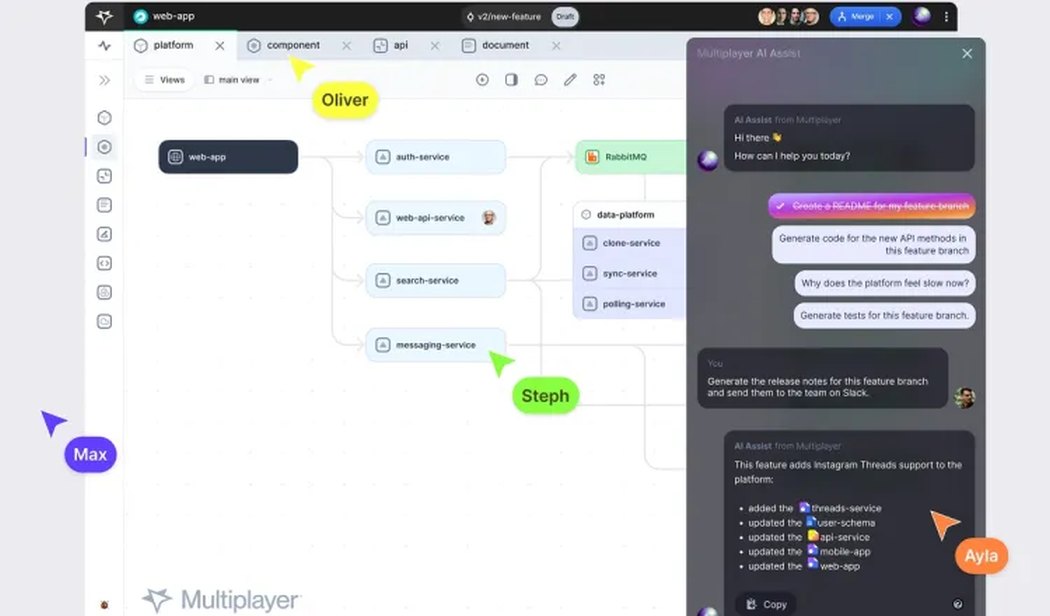Multiplayer emerges from Stealth with $3M in funding to make it easier for teams to work on distributed software with AI

For years, development teams have been stuck using outdated or makeshift methods like physical whiteboards or inadequate diagramming tools to collaborate on backend software design. But things are changing. One tech startup is on a mission to transform distributed software development using artificial intelligence (AI).
Enter Multiplayer, a new tech startup that has recently come out of stealth mode with an AI-powered collaborative tool to enable teams toto enable teams to develop and manage distributed software. Don’t let the name fool you – this startup isn’t really about gaming. Multiplayer is all about assisting contemporary startups that operate with remote teams in managing their backend software services. Created by developers themselves, it’s a tool designed to cater to the needs of fellow developers.
Today, Multiplayer announced it has exited the stealth mode with $3M in funding led by Bowery Capital, with participation from Okapi Venture Capital, Mitch Wainer, co-founder of DigitalOcean, and Edith Harbaugh, founder of LaunchDarkly.
In an email to Tech Startups, Multiplayer co-founder and CEO Steph Johnson said: “Having been immersed in the developer world for years at DigitalOcean and MongoDB, I’ve observed the communication gaps within development teams. There needs to be a better way to visualize and communicate architectural design decisions when working on distributed software. Surprisingly, in a world with so many dev tools, nothing facilitates seamless collaboration on backend software like Multiplayer, which we built specifically for this purpose.”
The inspiration to launch Multiplayer sprang from Steph’s time working at MongoDB, Digital Ocean, and various other developer tool ventures. Later on, he discovered a gap in the market – a lack of sufficient developer tools to effectively visualize and communicate architectural design choices while collaborating on distributed software projects.
“I spent time watching developers communicate and collaborate. I saw the trouble they have communicating when it comes to distributed software and working on that together. So after promoting a lot of other people’s great ideas, I decided it was time to promote one of my own, and thus teamed up with Tom to start Multiplayer,” Johnson added.
Steph’s co-founder and CTO is her husband Thomas Johnson, who brings 20-plus years as a developer at companies like Citrix, “This is an idea whose time has come. With distributed software being the norm today and teams being more spread out than ever, the gap in the market for a tool like Multiplayer has become very clear. Developers no longer need to bypass design reviews because they are ‘too much trouble.’ Multiplayer gives them an easy, organized way to share ideas and information before final implementation.”
Regarding their marriage and collaboration, Steph Johnson shared, “We often get questions about this. Having been a head of communications for public companies, my interactions with CEOs were often more intense than a regular marriage. I was prepared for anything. Additionally, our skills complement each other remarkably well. I handle all things related to the market – that’s my focus: HR, sales, and marketing. Thomas, on the other hand, is the tech expert, and neither of us wants to step into the other’s role. We consider ourselves fortunate in that aspect.”
Commenting on the funding, Mitch Wainer, co-founder of DigitalOcean, said: “Companies all over the world are developing distributed software. These systems are becoming more complex and harder to change without breaking things. There’s a dire need for a dev tool that helps teams visualize and collaborate when making changes to their backend software. Multiplayer makes design reviews and feature development easier and more collaborative, targeting a massively underserved market in the dev tool space.”

Below are the key features of Multiplayer:
- AI Assist: Generates everything teams need for distributed software, including system architectures, APIs, service implementations, Infrastructure as Code (IaC), documentation, and more.
- Visualizes system architecture: Enables detailed views of specific features and changes in real-time.
- Design Intent Communication: Communicates design intent by pulling together multiple document types (i.e. platform diagrams, APIs, sketches, rich-text docs, source code) for a feature
- Formal Design Reviews: Enables formal design reviews and allows for feedback from all parties (team leads, developers, QA, CTO’s DevOps, etc.) before moving to implementation.
- Real-Time Collaboration: Facilitates real-time team collaboration among distributed teams (akin to Figma but for the back end).
• Enables version control + branching. - Version Control and Branching: Ensures that system architecture will be recorded in a shared, company-owned space where the architecture can be maintained and the evolution of the platform is retained.
- Centralized System Dashboard: Tames the SaaS sprawl by integrating with source control providers, SaaS, and cloud providers and provides a centralized system dashboard for teams.

